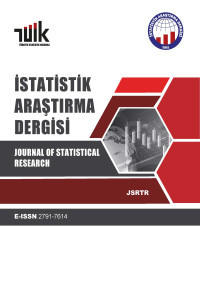Bölünmüş Parsellerin Endüstriyel Deney Tasarımında Kullanımı ve Dört Düzeyli Etkenlerin Bu Tasarımlara Yerleştirilmesi
Bölünmüş Parseller, Güçlü Tasarım, Eşdeşlik, Kesirli Çoketkenli Tasarımlar
The Use of Split Plot Designs in Industrial Design of Experiments and the Placement of Four-Level Factors into These Designs
Split Plots, Robust Design, Aliasing, Fractional Factorial Designs,
___
- ANKENMAN, B.E. (1999), Design of Experiments with Two-and Four-Level Factors, Journal of Quality Technology, 31, 4, 363-375.
- BINGHAM, D.R. and SISTER, R.R. (1999), Minimum Aberration Two-Level Fractional Factorial Split -Plot Designs, Technometrics, 41, 62-70.
- BINGHAM, D.R. and SISTER, R.R. (2001), Design Issues in Fractional Factorial Split-Plot Experiments. Journal of Quality Technology, 33, 1, 2-15.
- BISGAARD, S. (2000), the Design and Analysis of 2k-px2q-r Split plot Experiments, Journal of Quality Technology. 32, 1, 39-56.
- BOX, G.E.P., BISGAARD, S. and FUNG, C. (1988), An Explanation and Critique of Taguchi's Contributions to Quality Engineering, Quality and Reliability Engineering International, 4, 123- 131
- BOX, G.E.P., JONES, S. (1992), Slit-Plot Designs for Robust Product Experimentation, Journal of Applied Statistics, 19, I, 3-26.
- DANIEL, C. (1959), Use of Half-Normal Plots in Interpreting Factorial Two-Level Experiments, Technometrics, 1, 31 -341.
- FRIES, A. and HUNTER. W.G. (1980), Minimum Aberratian 2k-p Designs. Technometrics, 22, 601-608.
- HUANG, P., CHEN. D. and VOELKEL, J. (1998), Minimum Aberration Two-level Split-Plot Designs, Technometrics, 40, 314-326.
- KOWALSKI, S.M. (2002), 24 Run Split-Plot Experiments for Robust Parameter Design, Journal of Quality Technology, 34, 4, 399-410.
- LENTH, R.V. (1989), Quick and Easy Analysis of Unreplicated Factorials, Technometrics, 31, 469-473.
- LOEPPKY, J.L. and SISTER. R.R. (2002), Analyzing Unreplicated Blocked or Split-Plot Fractional Factorial Designs, Journal of Quality Technology, 34, 3, 229-243.
- MONTGOMERY, D.C. (2000), Design and Analysis of Experiments, New York, NY: Wiley
- ISSN: 1303-6319
- Başlangıç: 2002
- Yayıncı: TÜİK
Şehirleşme Seviyelerinin Projeksiyonu Üzerine Bir Araştırma
Karmaşık Örnekleme Planlarında Çeşitli Varyans Tahmin Yöntemleri ve Uygulama
Hipertansiyonun Tahmini için Çoklu Tahmin Modellerinin Karşılaştırılması
Mevlüt TÜRE, İmran KURT, Ebru YAVUZ, Turhan KÜRÜM
Türkiye'nin Sosyo-Ekonomik Yapısının Kanonik Korelasyon Analizi ile İncelenmesi
Rasgele Sıkıştırma Yoluyla Weibull Dağılımının Yeni Bir Karakterizasyonu
Sevgi YURT ÖNCEL, Fazıl ALİEV ALİOĞLU, Funda AYGÜN
Sağdan Sansürlü Veriler için Parametrik Regresyon Modeli ve Kemik İliği Naklinde Kullanımı
Yüksel TERZİ, Yüksel BEK, Mehmet Ali CENGİZ
